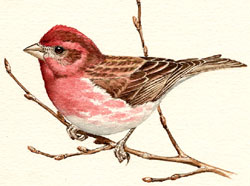Breeding Bird Atlases (BBA)
Find a Bird - BBA1
Breeding Bird Atlas 1 Species Accounts
Purple Finch
Carpodacus purpureus
Egg Dates
May 10 to July 2
Number of Broods
one

The Purple Finch is a common nester in all the counties of the state. It seems to occupy three distinct situations: deep coniferous or mixed forest, coniferous or mixed woodland borders along swamps and pasturelands (notably in more developed areas), and parks and suburbs with Norway Spruces and other coniferous ornamentals. In the two latter areas, it will readily appear at feeding stations throughout the nesting season.
Purple Finches are erratic migrants; the first spring arrivals usually appear in numbers in mid-March. Males establish territories and maintain regular singing perches from which they sometimes launch forth into flight song. The song is a high-pitched complex warble. Notes are rapid and connected with no two in succession on the same pitch. Overall, the song has a melodious liquid quality. Courtship begins in late April. Males sing continuously and present twigs; they posture elaborately—drooping the wings, exposing the bright rump, and erecting the crown feathers—and perform short hovering flights before the female. Nest building by the female, with assistance from the male, commences shortly after copulation. Preferred nest sites are 6 to 50 feet above the ground in spruce or pine; nests are also reported less frequently in Pasture-juniper, deciduous or evergreen shrubs, and apple trees. Nests are usually straddled on a branch and consist of fine twigs and grasses lined with finer grasses and quite often hairs of various types.
Clutch sizes of three to six eggs (usually four or five) are reported. The female does virtually all of the incubating. Incubation, commencing upon completion of the clutch, lasts about 13 days, during which time the incubating female is frequently fed by the male. Young are altricial and are tended by both parents. Fledging occurs at 14 days. After leaving the nest, the young continue to beg for food from the parent birds for an undetermined period of time until independence.
After nesting, purple finches wander erratically in segregated flocks, with females and young often seeming to outnumber males. Such postnesting groups may be evident in an area one year but absent the next. In September and October, there is usually a general southward movement through and out of the Massachusetts range. Birds are usually seen moving south solitarily or in small groups. Were it not for the distinctive metallic tick given by birds in flight, there would be little indication of their presence. Usually from December to February, Massachusetts birds are gone. Rarely, huge nomadic flocks may suddenly materialize in winter. Notable invasions have occurred in the years 1883-1884, 1939, 1941, 1950-1951, and 1963.
Map Legend and Data Summary
Atlas 1 data collected from 1975-1979


Note: uncommon in coniferous forests and plantings throughout the state; possible declining
Bradford G. Blodget



